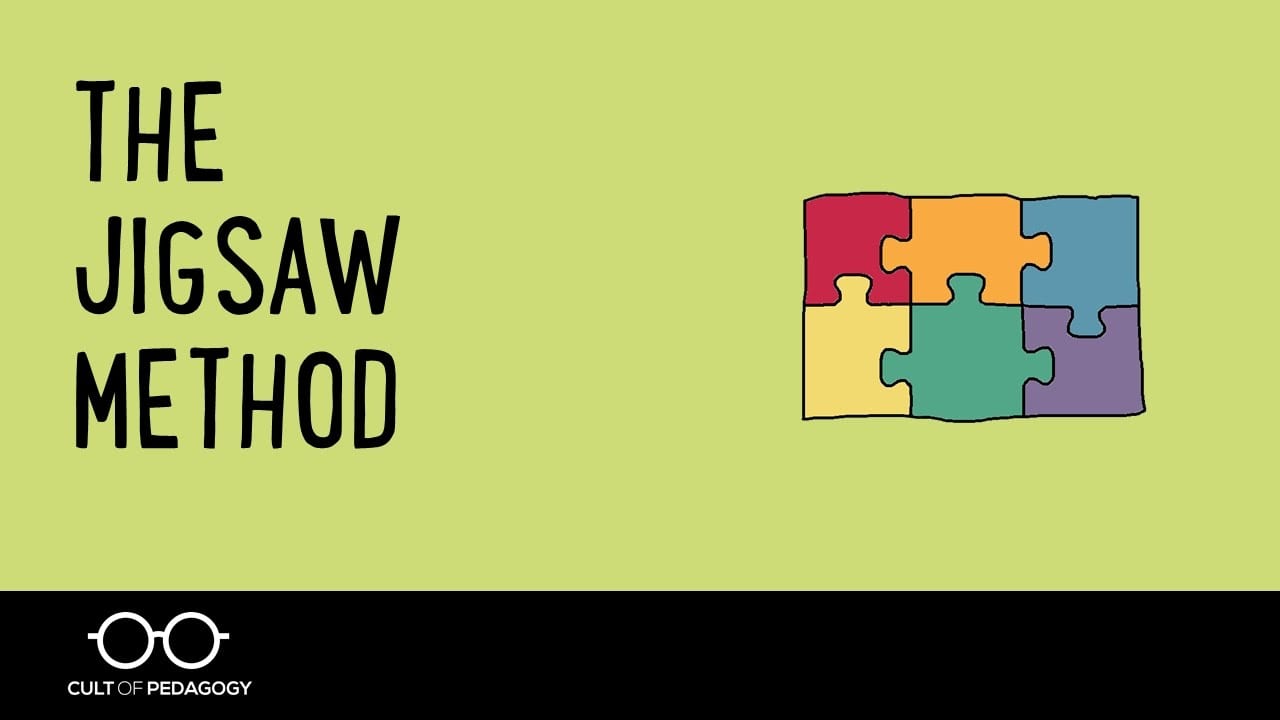This post is about how to use the Jigsaw Method. First we will look at the basic structure of the Jigsaw, and then a variation known as Jigsaw II, and finally you will learn some tips for troubleshooting this strategy.
So what is the Jigsaw Method? Developed by Elliot Aronson in 1971, Jigsaw is a cooperative learning strategy where each student in a group takes responsibility for one chunk of the content, then teaches it to the other group members. Like the pieces of a jigsaw puzzle, students fit their individual chunks together to form a complete body of knowledge.
Here are the steps of a basic jigsaw (sometimes referred to as Jigsaw)
Step 1. The first step is to divide students into groups of 4 to 6 people per group. Jigsaw works best when you have the same number of students in each team, So avoid having some groups of four, some of five, and some of six.
Later we will look into what to do if you can’t divide students into perfectly even teams. For this example, we’ll assume you’re working with a class of exactly 30 students who can be divided evenly into groups of six. We’ll call these the Jigsaw Groups.
Step 2. Divide your content into 4 to 6 chunks. It’s important to divide the content into the same number of chunks as the number of students in each group. So if you have six students per group, break your content into six chunks. If you’re only going to have five students in each group, then you’ll only need five chunks.
Suppose you’re a history teacher and you’re doing an overview of different types of government. You could divide your content into these chunks: democracy, dictatorship, monarchy, republic, totalitarianism, and theocracy. By the way: These index cards just represent chunks of content. You don’t need to use actual index cards to do jigsaw. A chunk of content can be a section of a textbook chapter, a handout containing information, or an online resource.
Step 3: Assign one chunk of content to each person in the Jigsaw Group. Each group has one person responsible for one chunk of the content. That person will be expected to teach that chunk to the rest of the group. At this point, students don’t really interact with other members of their group; they just read and study their own chunk of content independently.
Then, their independent study is fortified by the next step… Step 4: Have students meet in Expert Groups. After each student has studied his or her chunk independently, they gather with all the other students who have been assigned to the same chunk. These are called Expert Groups. Within each expert group, students compare their ideas and work together to prepare some kind of presentation to give to their Jigsaw Groups. During this time, gaps in individual students’ knowledge can be filled, misconceptions can be cleared up, and important concepts can be reinforced.
Step 5: Students return to Jigsaw Groups. Now that students have studied their chunks in their expert groups, They return to their original jigsaw groups, where each student takes a turn presenting their chunk of information. Meanwhile, the other students listen carefully, take notes, and ask lots of questions. Once the first expert has gone, the others take their turns, As each “expert” teaches their chunk of content, The others in the group are learning it.
Step 6: Assess all students on all the content. The assessment can be a simple quiz to make sure all students got a basic understanding of all the material. Be sure to include all content chunks in this quiz. Jigsaw II is a variation on the basic structure of Jigsaw. Developed by Robert Slavin in 1986, Jigsaw II makes one significant tweak to the basic Jigsaw. The difference is in how the assessment is treated. In Jigsaw I, students are assessed individually and receive just one score. In Jigsaw II, quiz scores are given once to individual students, then each group’s scores are averaged to generate a group score.
This builds in competition between groups and encourages students to work harder at helping each other learn the material well. Here are a few tips for troubleshooting this strategy. One problem you might encounter is this: What if students don’t divide evenly? Now ideally, you’d have a perfectly divisible group. But as we all know, that kind of perfection rarely happens, and even if you have perfection in your plans, one absent student can throw your whole game off. First, remember that you can create groups of 4, 5, or 6 (and some jigsaw advocates even allow for groups of 2 or 3), so that should help minimize “extra” students. Still, if you end up with a few extras, just assign two students in the same group the same chunk. Now, what if some “experts” don’t teach the material very well? If this group is depending on this one student to teach them about monarchies, and he’s not the strongest student, that group is kind of out of luck. You can anticipate this problem when creating your groups.
One thing you can do, if you have an uneven number of students, is pair up two students on the same chunk who might be stronger together than they would be on their own. Also, it’s the responsibility of the expert group to make sure that everyone is prepared to present their chunk to their respective jigsaw groups. If one student isn’t really getting it, make sure the rest of the group gives that student extra preparation…
So they’ll be ready to teach the material to their jigsaw group. A full description of this strategy and its history can be found at the Jigsaw Classroom website.


